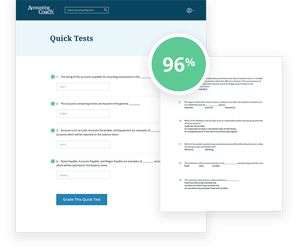For multiple-choice and true/false questions, simply press or click on what you think is the correct answer. For fill-in-the-blank questions, press or click on the blank space provided.
If you have difficulty answering the following questions, read our In-Depth Explanation for this topic.
True
False
True
False
True
False
True
False
True
False
True
False
True
False
True
False
True
False
True
False
True
False
True
False
True
False
Double-declining-balance
Straight-line
Sum-of-the-years'-digits
Cost Minus Salvage Value
Cost Minus Accumulated Depreciation
Cost Minus Salvage Value Minus Accumulated Depreciation
Estimated Fair Market Value
True
False
True
False
True
False

Get Our Premium Depreciation Test Questions When You Join PRO
Receive instant access to our entire collection of premium materials, including our 1,800+ test questions.
View All PRO FeaturesFeatures
Free
PRO
Read 3,034 Testimonials